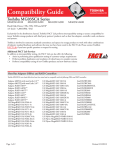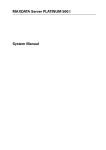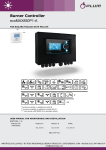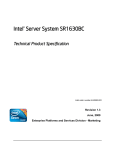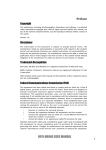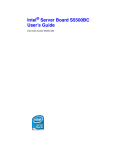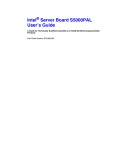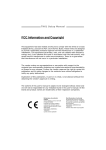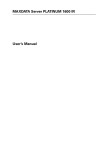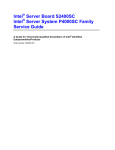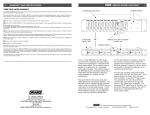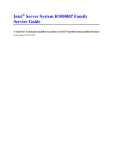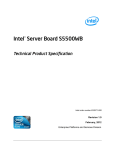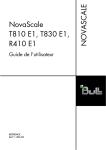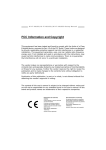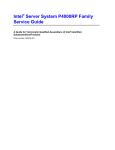Download Intel ® Server System H2000LP Family Service Guide
Transcript
Intel® Server System H2000LP Family Service Guide A Guide for Technically Qualified Assemblers of Intel® Identified Subassemblies/Products Order Number: G67054-001 Disclaimer Disclaimer ® Information in this document is provided in connection with Intel products. No license, express or implied, by estoppel or otherwise, to any intellectual property rights is granted by this document. Except as provided in Intel’s Terms and Conditions of Sale for such products, Intel assumes no liability whatsoever, and Intel disclaims any express or implied warranty, relating to sale and/or use of Intel products including liability or warranties relating to fitness for a particular purpose, merchantability, or infringement of any patent, copyright or other intellectual property right. Intel products are not designed, intended or authorized for use in any medical, lifesaving, or life sustaining applications or for any other application in which the failure of the Intel product could create a situation where personal injury or death may occur. Intel may make changes to specifications and product descriptions at any time, without notice. Intel server boards contain a number of high-density VLSI and power delivery components that need adequate airflow for cooling. Intel’s own chassis are designed and tested to meet the intended thermal requirements of these components when the fully integrated system is used together. It is the responsibility of the system integrator that chooses not to use Intel developed server building blocks to consult vendor datasheets and operating parameters to determine the amount of airflow required for their specific application and environmental conditions. Intel Corporation cannot be held responsible if components fail or the server board does not operate correctly when used outside any of their published operating or non-operating limits. Intel, Intel Pentium, and Intel Xeon are trademarks or registered trademarks of Intel Corporation or its subsidiaries in the United States and other countries. * Other names and brands may be claimed as the property of others. Copyright © 2012 Intel Corporation. All Rights Reserved. ii ® Intel Server System H2000LP Family Service Guide Safety Information Safety Information Important Safety Instructions Read all caution and safety statements in this document before performing any of the instructions. See also Intel® Server Boards and Server Chassis Safety Information on the Intel® Server Deployment Toolkit 3.0 CD and/or at http://www.intel.com/support/motherboards/server/sb/cs-010770.htm. Wichtige Sicherheitshinweise Lesen Sie zunächst sämtliche Warnund Sicherheitshinweise in diesem Dokument, bevor Sie eine der Anweisungen ausführen. Beachten Sie hierzu auch die Sicherheitshinweise zu Intel®Serverplatinen und Servergehäusen auf der Intel® Server Deployment Toolkit 3.0 CD oder unter http://www.intel.com/support/motherboards/server/sb/cs-010770.htm. Consignes de sécurité Lisez attention toutes les consignes de sécuritéet les mises en garde indiquées dans ce document avant de suivre toute instruction. Consultez Intel® Server Boards and Server Chassis Safety Information sur le Intel® Server Deployment Toolkit 3.0 CD ou bien rendez-vous sur le site http://www.intel.com/support/motherboards/server/sb/cs-010770.htm. Instrucciones de seguridad importantes Lea todas las declaraciones de seguridad y precaución de este documento antes de realizar cualquiera de las instrucciones. Vea Intel® Server Boards and Server Chassis Safety Information en el Intel® Server Deployment Toolkit 3.0 CD y/o en http://www.intel.com/support/motherboards/server/sb/cs-010770.htm. 重要安全指导 在执行任何指令之前,请阅读本文档中的所有注意事项及安全声明。和/或 http://www.intel.com/support/motherboards/server/sb/cs-010770.htm 上的 Intel® Server Boards and Server Chassis Safety Information(《Intel 服务器主板与服务器机箱安全信息》)。 ® Intel Server System H2000LP Family Service Guide iii Warnings Warnings Heed safety instructions: Before working with your server product, whether you are using this guide or any other resource as a reference, pay close attention to the safety instructions. You must adhere to the assembly instructions in this guide to ensure and maintain compliance with existing product certifications and approvals. Use only the described, regulated components specified in this guide. Use of other products/components will void the UL listing and other regulatory approvals of the product and will most likely result in noncompliance with product regulations in the region(s) in which the product is sold. System power on/off: The power button DOES NOT turn off the system AC power. To remove power from the system, you must unplug the AC power cord from the wall outlet. Make sure the AC power cord is unplugged before you open the chassis, add, or remove any components. Hazardous conditions, devices and cables: Hazardous electrical conditions may be present on power, telephone, and communication cables. Turn off the server and disconnect the power cord, telecommunications systems, networks, and modems attached to the server before opening it. Otherwise, personal injury or equipment damage can result. Electrostatic discharge (ESD) and ESD protection: ESD can damage disk drives, boards, and other parts. We recommend that you perform all procedures in this chapter only at an ESD workstation. If one is not available, provide some ESD protection by wearing an antistatic wrist strap attached to chassis groundany unpainted metal surfaceon your server when handling parts. ESD and handling boards: Always handle boards carefully. They can be extremely sensitive to ESD. Hold boards only by their edges. After removing a board from its protective wrapper or from the server, place the board component side up on a grounded, static free surface. Use a conductive foam pad if available but not the board wrapper. Do not slide board over any surface. Installing or removing jumpers: A jumper is a small plastic encased conductor that slips over two jumper pins. Some jumpers have a small tab on top that you can grip with your fingertips or with a pair of fine needle nosed pliers. If your jumpers do not have such a tab, take care when using needle nosed pliers to remove or install a jumper; grip the narrow sides of the jumper with the pliers, never the wide sides. Gripping the wide sides can damage the contacts inside the jumper, causing intermittent problems with the function controlled by that jumper. Take care to grip with, but not squeeze, the pliers or other tool you use to remove a jumper, or you may bend or break the pins on the board. iv ® Intel Server System H2000LP Family Service Guide Preface Preface About this Manual This manual is written for system technicians who are responsible for troubleshooting, upgrading, and repairing this server system. This document provides a brief overview of the features of the server board/chassis, a list of accessories or other components you may need, troubleshooting information, and instructions on how to add and replace components on the Intel® Server System H2000LP family products. For the latest revision of this manual, go to http://www.intel.com/p/en_US/support. Table 1. Intel® Server System H2000LP family product list Product Code Intel® Server System H2312LPJR ® Description With 4 S2400LP boards, 12x3.5" hard drive bay, 2x 1200W CRPS Intel Server System H2216LPJR With 4 S2400LP boards, 16x2.5" hard drive bay, 2x 1200W CRPS Intel® Server System H2312LPQJR With 4 S2400LPQ boards, 12x3.5" hard drive bay, 2x 1200W CRPS ® Intel Server System H2216LPQJR With 4 S2400LPQ boards, 16x2.5" hard drive bay, 2x 1200W CRPS Intel® Server System H2312LPFJR With 4 S2400LPF boards, 12x3.5" hard drive bay, 2x 1200W CRPS ® Intel Server System H2216LPFJR With 4 S2400LPF boards, 16x2.5" hard drive bay, 2x 1200W CRPS Intel® Server System H2312LPKR With 4 S2400LP boards, 12x3.5" hard drive bay, 2x 1600W CRPS ® With 4 S2400LP boards, 16x2.5" hard drive bay, 2x 1600W CRPS ® Intel Server System H2312LPQKR With 4 S2400LPQ boards, 12x3.5" hard drive bay, 2x 1600W CRPS Intel® Server System H2216LPQKR With 4 S2400LPQ boards, 16x2.5" hard drive bay, 2x 1600W CRPS Intel Server System H2216LPKR ® Intel Server System H2312LPFKR With 4 S2400LPF boards, 12x3.5" hard drive bay, 2x 1600W CRPS Intel® Server System H2216LPFKR With 4 S2400LPF boards, 16x2.5" hard drive bay, 2x 1600W CRPS Manual Organization Chapter 1 provides a brief overview of the Intel® Server System H2000LP family. In this chapter, you will find a list of the server system features, and figures of the system and components to help you identify your system components and their locations. Chapter 2 provides instructions on adding and replacing components. Use this chapter for step-bystep instructions and diagrams for installing or replacing components such as the fan, power supply, and front panel board, among other components. Chapter 3 provides instructions on using the utilities that are shipped with the board or that may be required to update the system. This includes information for navigating through the BIOS Setup screens, performing a BIOS update, and resetting the password or BIOS defaults. At the back of this document, you will find appendices on safety, “Getting Help”, and warranty information. ® Intel Server System H2000LP Family Service Guide v Preface Additional Information and Software For additional information about this family of products or any of their supported accessories, refer to the following resources available at http://www.intel.com/support. Table 2. Server System References For this information or software Use this Document or Software For in-depth technical information about this product. Intel® Server System H2000LP Family Technical Product Specification For installation of supported spares and accessories Intel® Server System H2000LP Family Quick Installation User’s Guide For a list of supported Intel spares and accessories Spares and Configuration Guide For server configuration guidance and compatibility For system power budget guidance See the section on the web page titled, “Architecture/Specifications”. See the section on the web page titled, “System Integration/User Guides/Compatibility”. See the section on the web page titled, “Documents & Guides”. Intel® Server Configurator tool To be provided later. Power Budget Analysis Tool To be provided later. ® For software to manage your Intel Server System. Intel Server Management Software For system firmware updates and onboard device drivers Intel Deployment Assistant DVD See the section on the web page titled, “Software/Code”. Firmware and Drivers See the section on the web page titled, “Software/Code”. Product Safety and Regulatory document Intel Server Products - Product Safety and Regulatory Compliance Document See the section on the web page titled, “Regulations/Certification/Compliance”. vi ® Intel Server System H2000LP Family Service Guide Table of Contents Table of Contents Safety Information .................................................................................................iii Preface ....................................................................................................................v 1 Server System Features ......................................................................................1 Server System Feature Overview ............................................................................................... 1 Server System Components ...................................................................................................... 3 Front Panel ............................................................................................................................. 5 Back Panel .............................................................................................................................. 5 Server Board Components ........................................................................................................ 6 Intel® Light-Guided Diagnostics ................................................................................................ 7 System Recovery Jumpers ........................................................................................................ 8 Hard Disk Drive Carriers ............................................................................................... 8 Bezel 9 Hot-Swap SAS/SATA Backplane .................................................................................. 9 Advanced Management Options................................................................................. 11 2 Hardware Installations and Upgrades ..............................................................12 Before You Begin .................................................................................................................. 12 Tools and Supplies Needed ........................................................................................ 12 System Reference ...................................................................................................... 12 Cable Routing ....................................................................................................................... 12 For cable connection inside Node tray ........................................................................ 13 Removing and Installing the Front Bezel .................................................................................. 13 Removing the Front Bezel .......................................................................................... 13 Installing the Front Bezel ............................................................................................ 14 Removing and Installing the System Top Cover ........................................................................ 14 Removing the System Top Cover ............................................................................... 14 Installing the System Cover ........................................................................................ 15 Removing and Installing the Compute Node Tray ...................................................................... 15 Removing the Node Tray ............................................................................................ 16 Installing the Node Tray .............................................................................................. 16 Removing and Installing the Redundant Power Supply Unit........................................................ 16 Removing the Power Supply Unit ............................................................................... 17 Installing the Power Supply Unit ................................................................................. 17 Removing and Installing the Node Tray Air Duct ...................................................................... 17 Removing the Air Duct ................................................................................................ 18 Installing the Air Duct .................................................................................................. 18 Removing and Installing Processor .......................................................................................... 19 Removing Processor Heatsink(s)................................................................................ 19 Installing the Processor .............................................................................................. 19 Installing Processor Heatsink(s) ................................................................................. 21 Removing the Processor ............................................................................................ 22 Installing and Removing Memory ............................................................................................ 22 Installing Memory ....................................................................................................... 22 Removing Memory ..................................................................................................... 23 Installing and Removing Hot-swap Hard Drive ......................................................................... 23 ® Intel Server System H2000LP Family Service Guide vii Table of Contents Installing a Hard Disk Drive into 3.5” Hard Drive Carrier ............................................. 23 Installing a Hard Disk Drive into 2.5" Hard Drive Carrier ............................................. 24 Installing and Removing the PCIe Riser Assembly .................................................................... 25 On Riser Slot 1 ........................................................................................................... 25 Installing the PCI Riser Assembly and add-in card ..................................................... 25 Removing a PCI Add-in Card.................................................................................................. 26 On Riser Slot 2 ........................................................................................................... 27 Installing IOM riser and carrier assembly .................................................................... 27 Removing IO module revise........................................................................................ 29 Installing and Removing the Intel® Remote Management Module 4 Lite ...................................... 30 Installing the Intel® RMM4 Lite .................................................................................... 30 Installing the Intel® Storage Upgrade Key ................................................................................. 30 Installing the Intel® Storage Upgrade Key ................................................................... 30 Installing and Removing the Bridge Board ................................................................................ 31 Removing the Bridge Board ........................................................................................ 31 Installing the Bridge Board .......................................................................................... 32 Installing and Removing the Node Power Docking Board ........................................................... 32 Removing the NPD Board .......................................................................................... 32 Installing the NPD Board ............................................................................................ 33 Installing and Removing the Fan set in node tray ....................................................................... 33 Removing the Fan set................................................................................................. 33 Installing the Fan set .................................................................................................. 34 Installing and Removing the 2.5" Backplane Board .................................................................... 34 Removing the 2.5" Backplane board ........................................................................... 34 Installing the 2.5" Backplane board............................................................................. 35 Installing and Removing the 3.5" Backplane Board .................................................................... 36 Removing the 3.5" Backplane board ........................................................................... 36 Installing the 3.5" Backplane board............................................................................. 36 Installing and Removing the Power Distribution Board .............................................................. 37 Removing the PDB ..................................................................................................... 37 Installing the PDB ....................................................................................................... 38 Replacing the Backup Battery ................................................................................................. 39 Replacing the Front Control Panel board .................................................................................. 40 Removing the Front Control Panel .............................................................................. 40 Installing Front Control Panel Board ........................................................................... 41 Rack Mounting the Chassis ..................................................................................................... 43 Mounting the Chassis to Rack .................................................................................... 43 Removing the Chassis from Rack ............................................................................... 44 3 Server Utilities .................................................................................................46 Using the BIOS Setup Utility .................................................................................................. 46 Starting Setup ............................................................................................................. 46 Setup Navigation Keyboard Commands ..................................................................... 46 Setup Screen Menu Selection Bar .............................................................................. 47 BIOS Setup Utility Screens ......................................................................................... 47 Map of Screens and Functionality ............................................................................... 48 Appendix A: Technical Reference .........................................................................50 Power Supply Input Voltages ...................................................................................... 50 Power Supply Output Voltages ................................................................................... 50 System Environmental Specifications ......................................................................... 50 viii ® Intel Server System H2000LP Family Service Guide Table of Contents Appendix B: Regulatory and Compliance Information ..........................................52 Appendix C: LED Decoder ....................................................................................53 Appendix D: Getting Help .....................................................................................59 Warranty Information .................................................................................................. 59 Appendix E: Intel® Server Issue Report Form .......................................................60 ® Intel Server System H2000LP Family Service Guide ix List of Figures List of Figures Figure 1. Intel® Server System H2000LP Family (H2312LP as demonstrated) ............................ 1 Figure 2. Intel® Server System H2000LP Overview (H2312LP as demonstrated)........................ 3 Figure 3. Front View of Intel® Server System H2312LP with 12x3.5" HDD bays .......................... 4 Figure 4. Front View of Intel® Server System H2216LP with 16x2.5" HDD bays .......................... 4 Figure 5. Rear View of Intel® Server System H2000LP with Compute Node Numbering ............. 4 Figure 6. HDD array scheme on Intel® Server System H2312LP................................................. 4 Figure 7. HDD array scheme on Intel® Server System H2216LP................................................. 5 Figure 8. Front Panel Options ..................................................................................................... 5 Figure 9. Back Panel Feature Identification per Compute Node .................................................. 6 Figure 10. Server Board S2400LP Connector and Component Locations ................................... 6 Figure 11. Intel® Light-Guided Diagnostic LEDs - Server Board .................................................. 7 Figure 12. Configuration Jumpers ............................................................................................... 8 Figure 13. Front view of System Bezel ........................................................................................ 9 Figure 14. 12 x 3.5-inch Hard Drive Backplane Components (Front View) .................................. 9 Figure 15. 12 x 3.5-inch Hard Drive Backplane Components (Rear View) ................................. 10 Figure 16. 16 x 2.5-inch Hard Drive Backplane Components (Front View) ................................ 10 Figure 17. 16 x 2.5-inch Hard Drive Backplane Components (Rear View) ................................. 11 Figure 18. Cable Routing inside Node tray ................................................................................ 13 Figure 19. Removing the Front Bezel ........................................................................................ 14 Figure 20. Installing the Front Bezel .......................................................................................... 14 Figure 21. Removing the System Top Cover ............................................................................. 15 Figure 22. Installing the System Cover ...................................................................................... 15 Figure 23. Pulling out the Node Tray ......................................................................................... 16 Figure 24. Installing the Node Tray ........................................................................................... 16 Figure 25. Removing the PSU................................................................................................... 17 Figure 26. Installing the PSU..................................................................................................... 17 Figure 27. Removing the Air Duct ............................................................................................. 18 Figure 28. Installing the Air Duct ............................................................................................... 18 Figure 29. Removing Processor Heatsink ................................................................................. 19 Figure 30. Installing Processor – Open the Socket Lever .......................................................... 20 Figure 31. Installing Processor – Open the Load Plate.............................................................. 20 Figure 32. Installing Processor – Remove the processor protective cover................................. 20 Figure 33. Installing Processor .................................................................................................. 21 Figure 34. Installing Processor – Close the Load Plate ............................................................. 21 Figure 36. Installing Processor Heatsink ................................................................................... 22 Figure 37. Installing Memory ..................................................................................................... 23 Figure 38. Installing Hard Disk Drive – installing 3.5" HDD to carrier ......................................... 23 Figure 39. Installing Hard Disk Drive – Inserting 3.5" HDD assembly ........................................ 24 Figure 40. Installing Hard Disk Drive – Installing 2.5" HDD to carrier......................................... 24 Figure 41. Installing Hard Disk Drive – Inserting 2.5" HDD assembly ........................................ 25 Figure 42. Assembly riser with bracket ...................................................................................... 25 Figure 43. Installing Riser 1 assembly ....................................................................................... 25 Figure 44. Installing a PCI adapter to PCI Riser 1 Assembly ..................................................... 26 Figure 48. Removing PCIe add-in card from riser slot ...................................................................... 27 Figure 45. Install IO module ......................................................................................................... 28 Figure 46. Installing assembly to riser ............................................................................................ 28 Figure 47. Fastening the assembly in chassis ................................................................................... 29 x ® Intel Server System H2000LP Family Service Guide List of Figures Figure 48. Losse IOM assembly .................................................................................................... 29 Figure 49. Removing IOM assembly from chassis (TBU) ................................................................. 29 Figure 50. Removing IO module from assembly.............................................................................. 30 Figure 51. Installing the Intel® RMM4 Lite ................................................................................. 30 Figure 52. Installing the Intel® Storage Upgrade Key................................................................. 31 Figure 53. Removing the bridge board ...................................................................................... 32 Figure 54. Installing the Bridge Board ....................................................................................... 32 Figure 55. Removing the NPD board ........................................................................................ 33 Figure 56. installing the NPD board........................................................................................... 33 Figure 57. Removing the Node Fan set ..................................................................................... 34 Figure 58. Installing the Server Board ....................................................................................... 34 Figure 59. Removing the 2.5" backplane board......................................................................... 35 Figure 60. Align the backplane to the clamps on the chassis base ............................................ 35 Figure 61. Installing the 2.5" backplane board........................................................................... 36 Figure 62. Removing the 3.5" backplane board......................................................................... 36 Figure 63. Align the backplane to the clamps on the chassis base ............................................ 37 Figure 64. Installing the 3.5" backplane board........................................................................... 37 Figure 65. Removing the upper PDB......................................................................................... 38 Figure 66. Removing the lower PDB ......................................................................................... 38 Figure 67. Installing the lower PDB ........................................................................................... 38 Figure 68. Installing the upper PDB........................................................................................... 39 Figure 69. Replacing the Backup Battery .................................................................................. 40 Figure 70. Removing FP Assembly from Rack Handle .............................................................. 40 Figure 71. Disconnecting Control Panel Cable .......................................................................... 41 Figure 72. Removing Control Panel Board ................................................................................ 41 Figure 73. Installing Control Panel Board .................................................................................. 42 Figure 74. Connecting Cable to Front Panel Board ................................................................... 42 Figure 75. Installing Control Panel Assembly to Rack Handle ................................................... 43 Figure 76. Removing Inner Member from Slides ....................................................................... 43 Figure 77. Installing Slides to the Rack ..................................................................................... 43 Figure 78. Installing Inner Member to the Chassis .................................................................... 44 Figure 79. Installing the Chassis to Rack .................................................................................. 44 Figure 80. Extending Slides to Remove the Chassis ................................................................. 45 Figure 81. Removing the Inner Member from the Chassis ........................................................ 45 Figure 82. Diagnostic LED Placement Diagram .............................................................................. 53 ® Intel Server System H2000LP Family Service Guide xi List of Tables List of Tables Table 1. Intel® Server System H2000LP family product list ......................................................... v Table 2. Server System References........................................................................................... vi Table 3. Intel® Server System H2000LP Feature Summary ........................................................ 1 Table 4. Hard Disk Drive Options ................................................................................................ 8 Table 5. Intel® RAID C600-A Storage Upgrade Key Options for S2400LP ................................ 30 Table 6. BIOS Setup: Keyboard Command Bar ........................................................................ 46 Table 7. Screen Map ................................................................................................................. 48 Table 8. CRPS Input Voltage .................................................................................................... 50 Table 9. CRPS Output Voltage ................................................................................................. 50 Table 10. System Environmental Limits Summary .................................................................... 50 Table 11. POST Progress Code LED Example ......................................................................... 53 Table 12. Diagnostic LED POST Code Decoder ....................................................................... 54 xii ® Intel Server System H2000LP Family Service Guide List of Tables <This page is intentionally left blank.> ® Intel Server System H2000LP Family Service Guide xiii Server System Features 1 Server System Features This chapter briefly describes the main features of the Intel® Server System H2000LP family. This includes illustrations of the products, a list of the server system features, and diagrams showing the location of important components and connections on the server systems. Figure 1. Intel® Server System H2000LP Family (H2312LP as demonstrated) Server System Feature Overview Table 3 summarizes the features of the server systems. Table 3. Intel® Server System H2000LP Feature Summary Feature H2312LP Description 3.46 inches (87.9 mm) hight 17.24 inches (438.0 mm) wide 30.35 inches (771 mm) deep 84 pounds (38kg) – maximum system weight H2216LP 3.46 inches (87.9 mm) hight 17.24 inches (438.0 mm) wide 28.86 inches (733 mm) deep 71 pounds (32kg) – maximum system weight Dimensions Compute Node Processor Support Support for one or two Intel® Xeon® processors E5-2400 product family with a Thermal Design Power (TDP) of up to 95 W(8-core and 6-core), or 80W(4-core) and below. Compute Node Memory 12 DIMM slots – 2 DIMMs/Channel – 3 memory channels per processor Unbuffered ECC or Registered DDR3 DIMMs ® Intel Server System H2000LP Family Service Guide 1 Server System Features Feature Chipset on each Compute Node Description Memory DDR3 data transfer rates of 800, 1066, 1333 MT/s and 1600 MT/s DDR3 standard I/O voltage of 1.5V (all speed) and DDR3 Low Voltage of 1.35V (1333MT/s or below). Intel® C600-A chipset with support for optional Storage Upgrade Keys Compute Node External I/O connections Compute Node Internal I/O connectors/headers Bridge Slot to extend board I/O SCU0 (Four SAS 3Gb/s ports) to backplane Front control panel signals One Type-A USB 2.0 connector (USB port 2) One 2x7pin header for system FAN module One DH-10 serial Port A connector One SATA 6Gb/s (Port 0) for DOM One 2x4 pin header for Intel® RMM4 Lite One 1x4 pin header for Storage Upgrade Key Available I/O Module Options (Sold Separately) The following I/O modules utilize a single proprietary on-board connector. An installed I/O module can be supported in addition to standard on-board features and any add-in expansion cards. Quad Port Intel® I350 GbE I/O Module Dual Port Intel® X540 10GbE I/O Module Dual Port Intel®82599 10GbE I/O Module System Fans by each Compute Node Three sets of dual rotor managed system fans One internal power supply fan for each installed power supply unit Compute Node Riser Cards Two PCIe Gen III x16 riser slots Riser slot 1 support PCIe Gen III x16 Riser(x8 Electrical for S2400LPQ and S2400LPF) with LP PCIe add-in card Riser slot 2 supports PCIe Gen III x 8 Riser (for Gen II Intel® rIOM and RMM4 NIC port) Node Video Integrated 2D Video Controller 128 MB DDR3 Memory Node On-board storage controllers and options One single port SATA connectors(on baseboard for DOM) capable of supporting up to 6 GB/sec SCU0 4-port up to 3 GB/sec SAS or 6 GB/sec SATA through bridge board Intel® RAID C600 Upgrade Key support providing optional expanded SATA/SAS RAID capabilities Server Management DB-15 Video connectors Two RJ-45 Network Interface for 10/100/1000 LAN One stacked two port USB 2.0 (Port 0/1) connectors One dedicated 1GbE management port on rIOM carrier(Optional) One InfiniBand* QDR QSFP port (Board SKU: S2400LPQ) One InfiniBand* FDR QSFP port (Board SKU: S2400LPF). Onboard ServerEngines* LLC Pilot III* Controller Support for Intel® Remote Management Module 4 Lite solutions Intel® Light-Guided Diagnostics on field replaceable units Support for Intel® System Management Software Support for Intel® Intelligent Power Node Manager (Need PMBus-compliant power supply). 1200w AC Common Redundant Power Supply (CRPS), 80 plus Platinum with PFC, supporting CRPS configuration. Chassis SKU: H2312LPJR, H2216LPJR Power Supply Options 1600w AC Common Redundant Power Supply (CRPS), 80 plus Platinum with PFC, supporting CRPS configuration. Chassis SKU: H2312LPKR, H2216LPKR Storage Bay Options 12x 3.5-inch SATA/SAS HDD bays (SKU: H2312LP serial) 2 ® Intel Server System H2000LP Family Service Guide Server System Features Feature Description 16x 2.5-inch SATA/SAS HDD bays (SKU: H2216LP serial) Available Rack Mount Kit Options Basic slide rail kit (AXXELVRAIL), bundled with system package Server System Components This section helps you identify the components of your server system. If you are near the system, you can also use the Quick Reference Label provided on the inside of the chassis cover to assist in identifying components. The H2000LP family has four compute nodes in the chassis. The whole system view is as below (with top cover removed). A B C D Compute Node 3 Tray Compute Node 1 Tray Compute Node 4 Tray Compute Node 2 Tray E F G H Common Redundant Power Supply HDD bays with Hot Swap Backplane Upper and Lower Power Distribution Boards Front Control Panel Figure 2. Intel® Server System H2000LP Overview (H2312LP as demonstrated) There are two configurations of hard disk drives for H2000LP family. ® Intel Server System H2000LP Family Service Guide 3 Server System Features Figure 3. Front View of Intel® Server System H2312LP with 12x3.5" HDD bays Figure 4. Front View of Intel® Server System H2216LP with 16x2.5" HDD bays The Compute Node in the chassis has dedicated numbering by position. Figure 5. Rear View of Intel® Server System H2000LP with Compute Node Numbering Each Compute Node has dedicated Hard Disk Drive array based on backplane controller design. Below are schemes for HDD array in correspondent to Compute Node. Figure 6. HDD array scheme on Intel® Server System H2312LP 4 ® Intel Server System H2000LP Family Service Guide Server System Features Figure 7. HDD array scheme on Intel® Server System H2216LP Front Panel The system contains two sets of control panels on left and right rack handles. Each control panel contains two sets of control buttons and LEDs for each Compute Node. Below is the scheme of control panel. A B C D System Power Button with LED System ID LED Button System Status LED Network Link/Activity LED Figure 8. Front Panel Options Back Panel Compute Node back panel scheme is as below: Description ® Description A NIC port 1 (RJ45) E Status LED B NIC port 2 (RJ45) F Dual port USB connector C DB15 video out G QSFP Connector Intel Server System H2000LP Family Service Guide 5 Server System Features Description ID LED D H Description InfiniBand status and Diagnostic LED Figure 9. Back Panel Feature Identification per Compute Node Server Board Components This section helps you identify the components and connectors on the server board in each Compute Node. Description Description Description Description A CPU2 VR I USB x 2 Q Storage Upgrade Key B CPU1 DIMM(6 Total) J Status and ID LED R BIOS Recovery Z Reset BIOS Configuration C Bridge Board Connector K BMC S Serial Port A AA CPU1 D PCH C600-A L VGA Out T TPM AB CPU1 VR E Riser Slot2 (PCIe Gen3x16 with x8 Electrical) M Dual Port 1Gbe NIC U RMM4 Lite AC CPU2 DIMM(6 Total) F Infiniband QDR N NIC Port 2 V Battery AD 2x3 PWR Connector G POST and QSFP LED O NIC Port 1 W SATA DOM AE CPU2 H QSFP Port P Riser Slot 1(PCIe Gen3x16 with x8 Electical) X Clear Password AF 2x7 Fan Control Connector Y ME Firmware Update Figure 10. Server Board S2400LP Connector and Component Locations 6 ® Intel Server System H2000LP Family Service Guide Server System Features Intel® Light-Guided Diagnostics A Diagnostic LED Group B QSFP Link/Activity LED ® Figure 11. Intel Light-Guided Diagnostic LEDs - Server Board The server system contains the following diagnostic LEDs, each providing the following functions: Section A – POST Code Diagnostic LEDs on the server board change color or state (off, green, red, and amber) according to the POST sequence. Section B – Link and Activity LEDs for QSFP Infiniband. The System Identification LED on the front and back panel helps identify the server from among several servers. The ID LED is off by default, and blue when activated by button or software. The System Status LED on the front and back panels shows the overall health of the system (green, blinking green, blinking amber, amber, off). ® Intel Server System H2000LP Family Service Guide 7 Server System Features System Recovery Jumpers Mode of Operation Normal Normal mode 2-3 Update BMC in force update mode J9F2: BIOS Recovery Mode 1-2 Normal Normal mode, password in protection 2-3 Recovery BIOS in recovery mode J6E1: Password Clear 2-4 Normal Normal mode 4-6 Update ME in force update mode 10-12 Normal Normal mode 8-10 Recovery BIOS in recovery mode 1-3 Normal Normal mode 3-5 Clear BIOS Settings BIOS settings are reset to factory default Jumper Name J9C2: BMC Force Update jumper J6E1: ME Force Update J6E1: BIOS Default Jumper Position 1-2 Note Figure 12. Configuration Jumpers Hard Disk Drive Carriers The Intel® Server System H2000LP ships in two different basic SKUs, and with different maximum number of hard disk drives, see below table for details: Table 4. Hard Disk Drive Options Intel® Server System Supported Hard Drive Type Maximum Hard Drive Number H2312LP 3.5-inch 12 H2216LP 2.5-inch 16 Note: 1. SAS drives are only supported when proper Intel® RAID C600 Upgrade Key is installed. 8 ® Intel Server System H2000LP Family Service Guide Server System Features 2. Drives can consume up to 17 watts of power each. Drives must be specified to run at a maximum ambient temperature of 45°C. 3. The Intel® Server System H2000LP does not support all SAS or Serial ATA (SATA) hard drives. For a web link to a list of supported hard drives, see Additional Information and Software on page vi. Bezel The front bezel is available as optional accessory for the server system: Figure 13. Front view of System Bezel Hot-Swap SAS/SATA Backplane The Hot-Swap SAS/SATA backplane serves as an interface between the mother board and the system drives. The following diagrams show the location for each connector found on the backplane. 12 x 3.5-inch Hard Drive Backplane A SATA/SAS connectors for Node 1 B SATA/SAS connectors for Node 2 C SATA/SAS connectors for Node 3 D SATA/SAS connectors for Node 4 Figure 14. 12 x 3.5-inch Hard Drive Backplane Components (Front View) ® Intel Server System H2000LP Family Service Guide 9 Server System Features A 20-pin Front Panel cable connector for Node 2, 4 B 2-Blade Compute Node Power connector for Node 4 C 2x40 pin Bridge Board connector for Node 4 D 2x9 pin Power supply input connector E 2x9 pin Power supply input connector F 2x7 pin Power Control cable connector G 2-Blade Compute Node Power connector for Node 3 H 2x40 pin Bridge Board connector for Node 3 I 2x40 pin Bridge Board connector for Node 1 J 20-pin Front Panel cable connector for Node 1, 3 K 2Blade Compute Node Power connector for Node 1 L 2x9 pin Power supply input connector M 2x9 pin Power supply input connector N 2x40 pin Bridge Board connector for Node 2 O 2-Blade Compute Node Power connector for Node 2 Figure 15. 12 x 3.5-inch Hard Drive Backplane Components (Rear View) 16 x 2.5-inch Hard Drive Backplane A SATA/SAS connectors for Node 1 B SATA/SAS connectors for Node 2 C SATA/SAS connectors for Node 3 D SATA/SAS connectors for Node 4 Figure 16. 16 x 2.5-inch Hard Drive Backplane Components (Front View) 10 ® Intel Server System H2000LP Family Service Guide Server System Features A 2Blade Compute Node Power connector for Node 4 B 2x40 pin Bridge Board connector for Node 4 C 2x9 pin Power supply input connector D 2x7 pin Power Control cable connector E 2x9 pin Power supply input connector F 2Blade Compute Node Power connector for Node 3 G 2x40 pin Bridge Board connector for Node 3 H 2x40 pin Bridge Board connector for Node 1 I 20-pin Front Panel cable connector for Node 1, 3 J 2Blade Compute Node Power connector for Node 1 K 2x9 pin Power supply input connector L 2x9 pin Power supply input connector M 2x40 pin Bridge Board connector for Node 2 N 2Blade Compute Node Power connector for Node 2 O 20-pin Front Panel cable connector for Node 2, 4 Figure 17. 16 x 2.5-inch Hard Drive Backplane Components (Rear View) Advanced Management Options Intel® Remote Management Module 4 Lite The Intel® Remote Management Module 4 Lite plugs into a dedicated connector on the server board and provides additional server management functionality to the Compute Node. This module, together with dedicated management port on IOM carrier sitting on Slot2 riser provides a dedicated web server for viewing server information and remote control of the system. It also provides Remote KVM Redirection and USB Media Redirection allowing USB devices attached to the remote system to be used on the managed server. For instructions on installing the Intel® Remote Management Module 4 Lite, see “Installing and Removing the Intel® Remote Management Module 4 Lite”. ® Intel Server System H2000LP Family Service Guide 11 Hardware Installations and Updates 2 Hardware Installations and Upgrades Before You Begin Before working with your server product, pay close attention to the “Safety Information” on page iii at the beginning of this manual. Note: Whenever you service the system, you must first power down the server and unplug all peripheral devices and the AC power cord. Tools and Supplies Needed Phillips* (cross head) screwdriver (#1 bit and #2 bit) Needle nosed pliers Anti-static wrist strap and conductive foam pad (recommended) System Reference All references to left, right, front, top, and bottom assume the reader is facing the front of the chassis as it would be positioned for normal operation. Note: The Intel® Server System H2000LP is shown for illustration purposes; server components with the product family are identical. Cable Routing The Intel® Server System H2000LP family is a high density system, containing four identical Compute Nodes inside. There are a few cables for chassis internal routing. Each Compute Node is installed in tray and can be hot swapped without any impact to other nodes. When you add or remove components from Compute Node tray, make sure your cables are routed correctly before plug in the node tray back to chassis. Use caution to make sure no cables or wires are pinched and that the airflow from the fans is not blocked. Use the figures below to determine the correct cable routing. 12 ® Intel Server System H2000WP Family Service Guide Hardware Installations and Updates For cable connection inside Node tray Yellow Lines: Fan cable connection Red Line: Mother board power cable connection Blue line: Fan control signal cable connection Figure 18. Cable Routing inside Node tray Removing and Installing the Front Bezel Removing the Front Bezel If your system includes a front bezel, follow these steps to remove the front bezel: 1. Unlock the bezel if it is locked. 2. Remove the left end of front bezel from rack handle (see letter A). 3. Rotate the front bezel anticlockwise to release the latches on the right end from the rack handle (see letter B). ® Intel Server System H2000WP Family Service Guide 13 Hardware Installations and Updates Figure 19. Removing the Front Bezel Installing the Front Bezel Note: Before installing the bezel, you must install the rack handles. 1. Lock the right end of the front bezel to the rack handle (see letter A). 2. Rotate the front bezel clockwise till the left end clicks into place (see letter B). 3. Lock the bezel if needed. Figure 20. Installing the Front Bezel Removing and Installing the System Top Cover Removing the System Top Cover The server system must be operated with the system cover in place to ensure proper cooling. You will need to remove the top cover to add or replace components (backplane, main power cables, power distribution board) inside of the server. Before removing the top cover, power down the server and unplug all peripheral devices and the power cable(s). Note: A non-skid surface or a stop behind the server system may be needed to prevent the server system from sliding on your work surface. 1. Observe the safety and ESD precautions at the beginning of this book. 2. Turn off all peripheral devices connected to the server. Turn off the server. 3. Disconnect the power cord. 4. Remove the screws (see letter A). 14 ® Intel Server System H2000WP Family Service Guide Hardware Installations and Updates 5. Lift upwards from B edge (see letter B). Figure 21. Removing the System Top Cover Installing the System Cover 1. Place system cover onto the chassis and engage recessed edge at rear of cover (see letter A). 2. Put down the cover from B edge and tighten the screw at front (see letter B). Figure 22. Installing the System Cover Removing and Installing the Compute Node Tray Each Compute Node tray is identical in the chassis. They are designed for either “cold” or “hot” swappable. The Node Tray can only be plugged from rear chassis. ® Intel Server System H2000WP Family Service Guide 15 Hardware Installations and Updates Removing the Node Tray 1. Carefully push in the latch on the left hand of Node Tray. 2. Pull the handle with the Node Tray while still press the latch. Figure 23. Pulling out the Node Tray Installing the Node Tray 1. Align and slide in the Node Tray to the chassis rail. 2. Push the Node Tray along the rail until the latch locks in position with a “tick”. Figure 24. Installing the Node Tray Removing and Installing the Redundant Power Supply Unit The system equipped with two CRPS for redundancy. Each of them can be hot swappable. 16 ® Intel Server System H2000WP Family Service Guide Hardware Installations and Updates Removing the Power Supply Unit 1. Carefully push in the latch on the right hand of PSU. 2. Pull the handle with the PSU while still press the latch. Figure 25. Removing the PSU Installing the Power Supply Unit 1. Align and slide in the PSU to the power cage rail. 2. Push the PSU along the rail until the latch locks in position with a “tick”. Figure 26. Installing the PSU Removing and Installing the Node Tray Air Duct Always operate your server system with the air duct in place. The air duct is required for proper airflow within the server system. ® Intel Server System H2000WP Family Service Guide 17 Hardware Installations and Updates Removing the Air Duct 1. lift the rear edge of the air duct. 2. Remove the air duct when it is about 45 degrees to the node tray. Figure 27. Removing the Air Duct Installing the Air Duct 1. Put the A edge of air duct down to fan set edge first with 45 degrees. (see letter A). 2. Then slowly put down the B edge of air duct down until the sir duct surface is aligned with tray side wall. (see letter B) Figure 28. Installing the Air Duct 18 ® Intel Server System H2000WP Family Service Guide Hardware Installations and Updates Removing and Installing Processor The heatsink has thermal interface material (TIM) on the underside of it. Use caution so that you do not damage the thermal interface material. Use gloves to avoid sharp edges. Removing Processor Heatsink(s) The heatsink is attached to the server board/processor socket with captive fasteners. Using a #2 Phillips* screwdriver, loosen the four screws located on the heatsink corners in a diagonal manner using the following procedure: 1. Using a #2 Phillips* screwdriver, start with screw 1 and loosen it by giving it two rotations and stop (see letter A). (IMPORTANT: Do not fully loosen.) 2. Proceed to screw 2 and loosen it by giving it two rotations and stop (see letter B). Similarly, loosen screws 3 and 4. Repeat steps A and B by giving each screw two rotations each time until all screws are loosened. 3. Lift the heatsink straight up (see letter C). Figure 29. Removing Processor Heatsink Installing the Processor Caution: Processor must be appropriate: You may damage the server board if you install a processor that is inappropriate for your server. For a web link to the list of compatible processor(s), see “Additional Information and Software” on page vi. Caution: ESD and handling processors: Reduce the risk of electrostatic discharge (ESD) damage to the processor by doing the following: 1. Touch the metal chassis before touching the processor or server board. Keep part of your body in contact with the metal chassis to dissipate the static charge while handling the processor. 2. Avoid moving around unnecessarily. Caution: Protective socket cover needs to be removed for proper cooling of the processor; failure to remove the cover could result in damage to the system. ® Intel Server System H2000WP Family Service Guide 19 Hardware Installations and Updates 1. Open the Socket Lever. Push the lever handle down and away from the socket to release it. (See letter A). Rotate the lever open all the way(see letter B). Figure 30. Installing Processor – Open the Socket Lever 2. Open the Load Plate. Push the rear tab with your finger tip to bring the front end of the load plate up slightly. (See letter A). Open the load plate as shown. (See letter B). Figure 31. Installing Processor – Open the Load Plate 3. Remove the processor protective cover. Take the processor out of the box and remove the protective shipping cover (see letter A). Figure 32. Installing Processor – Remove the processor protective cover Note: The underside of the processor has components that may damage the socket pins if installed improperly. Processor must align correctly with the socket opening before installation. DO NOT DROP processor into the socket! 4. Install the processor. Orient the processor with the socket so that the orientation notches on the processor align with the two orientation posts on the socket. (see letter A) 20 ® Intel Server System H2000WP Family Service Guide Hardware Installations and Updates Figure 33. Installing Processor 5. Close the Load Plate and Socket Lever(see letter A). Close the socket lever (see letter B). Remove the protective cover after it been automatically disengaged from the load plate(see letter C). Figure 34. Installing Processor – Close the Load Plate Installing Processor Heatsink(s) Note: The processor heatsink for CPU1 and CPU2 are different. FXXCA90X90HS is for CPU1, while FXXE90X90HS is for CPU2. Mislocating the heatsink will cause serious thermal damage! 1. Remove the protective film on the TIM if present (see letter A). 2. Align heatsink fins to the front and back of the chassis for correct airflow. Airflow goes from front-to-back of chassis (see letter B). Each heatsink has four captive fasteners and should be tightened in a diagonal manner using the following procedure: 3. Using a #2 Phillips* screwdriver, start with screw 1 and engage screw threads by giving it two rotations and stop (see letter C). (Do not fully tighten.) 4. Proceed to screw 2 and engage screw threads by giving it two rotations and stop (see letter D). Similarly, engage screws 3 and 4. 5. Repeat steps C and D by giving each screw two rotations each time until each screw is lightly tightened up to a maximum of 8 inch-lbs torque (see letter E). ® Intel Server System H2000WP Family Service Guide 21 Hardware Installations and Updates Figure 35. Installing Processor Heatsink Removing the Processor 1. Remove the processor heatsink, see Figure 30. 2. Open the socket lever, see Figure 31. 3. Open the load plate, see Figure 32. 4. Remove the processor. Installing and Removing Memory Installing Memory 1. Locate the DIMM sockets. Make sure the clips at either end of the DIMM socket(s) are pushed outward to the open position (see letter A). 2. Holding the DIMM by the edges, remove it from its anti-static package. Position the DIMM above the socket. Align the notch on the bottom edge of the DIMM with the key in the DIMM socket (see letter B). 3. Insert the bottom edge of the DIMM into the socket (see letter C). When the DIMM is inserted, push down on the top edge of the DIMM until the retaining clips snap into place (see letter D). Make sure the clips are firmly in place (see letter E). 22 ® Intel Server System H2000WP Family Service Guide Hardware Installations and Updates Figure 36. Installing Memory Removing Memory 1. Locate the DIMM sockets. Gently spread the retaining clips at each end of the socket. The DIMM lifts from the socket. 2. Holding the DIMM by the edges, lift it from the socket, and store it in an anti-static package. Installing and Removing Hot-swap Hard Drive Caution: If you don't install all drives, empty drive bays must be occupied by carriers with plastic drive blank provided to maintain proper system cooling. Installing a Hard Disk Drive into 3.5” Hard Drive Carrier 1. Remove the four screws securing the HDD interface bracket and install 3.5" HDD with screws shown in letter A. Figure 37. Installing Hard Disk Drive – installing 3.5" HDD to carrier 2. With the lever open, insert the hard disk drive assembly into the chassis (see letter A). Push in the lever to lock it into place (see letter B). ® Intel Server System H2000WP Family Service Guide 23 Hardware Installations and Updates Figure 38. Installing Hard Disk Drive – Inserting 3.5" HDD assembly Installing a Hard Disk Drive into 2.5" Hard Drive Carrier 1. Remove the four screws securing the plastic drive blank from the 2.5" HDD carrier and install the 2.5" HDD with screws shown in below drawing. Figure 39. Installing Hard Disk Drive – Installing 2.5" HDD to carrier 2. With the lever open, insert the hard disk drive assembly into the chassis, then push in the lever to lock it into place (See letter F). 24 ® Intel Server System H2000WP Family Service Guide Hardware Installations and Updates Figure 40. Installing Hard Disk Drive – Inserting 2.5" HDD assembly Installing and Removing the PCIe Riser Assembly On Riser Slot 1 Installing the PCI Riser Assembly and add-in card 1. Install the riser to bracket by fastening screws in below drawings. (See letter A) Figure 41. Assembly riser with bracket 2. Install the PCIe add-in card into the bracket assembly. (See letter B and C). Figure 42. Installing Riser 1 assembly 3. Install the riser assembly into the node tray. (See letter D and E). ® Intel Server System H2000WP Family Service Guide 25 Hardware Installations and Updates Figure 43. Installing a PCI adapter to PCI Riser 1 Assembly Removing a PCI Add-in Card You must remove the IOM carrier assembly together with PCIe add-in card riser assembly. 1. Remove IOM carrier assembly (letter A) by loosing the screws (letter B and C). Figure 44. Removing IOM assmbly 2. Remove PCIe riser assembly (letter B) by loosing the screw (letter A) Figure 45. Removing PCIe add-in card assembly 26 ® Intel Server System H2000WP Family Service Guide Hardware Installations and Updates 3. Remove PCIe add-in card from slot (letter C) and bracket (letter D). Figure 46. Removing PCIe add-in card from riser slot Note: Make sure that all empty add-in card slots have filler panels installed. On Riser Slot 2 Installing IOM riser and carrier assembly The IOM riser and carrier assembly are provided as optional accessory. This assembly provides the support to Intel® RMM4 dedicated NIC port and IO module. 1. Install the riser to bracket by fastening screws in below drawings. 2. Install IO module to IOM carrier using screw in letter B. ® Intel Server System H2000WP Family Service Guide 27 Hardware Installations and Updates Figure 47. Install IO module 3. Install the whole bracket to IOM riser slot indicated by letter C. Then install rear panel indicated by letter D. Figure 48. Installing assembly to riser 4. Fastening the assembly to chassis with three screws in letter E, F, and G. 28 ® Intel Server System H2000WP Family Service Guide Hardware Installations and Updates Figure 49. Fastening the assembly in chassis Removing IO module revise 1. Removing three screws marked as letter A, B, and C. Remove IOM assembly from chassis. Figure 50. Losse IOM assembly 2. Remove the IO module carrier from the riser as letter D and bracket as letter E. Figure 51. Removing IOM assembly from chassis (TBU) 3. Release screw in letter G, and remove IO module from assembly as letter F. ® Intel Server System H2000WP Family Service Guide 29 Hardware Installations and Updates Figure 52. Removing IO module from assembly Installing and Removing the Intel® Remote Management Module 4 Lite Installing the Intel® RMM4 Lite Locate the RMM4 Lite connector next to RISER SLOT_2, carefully pick up the Intel® RMM4 Lite module, match the alignment pin of the module and the connector on server board, and press to install. Figure 53. Installing the Intel® RMM4 Lite Installing the Intel® Storage Upgrade Key Installing the Intel® Storage Upgrade Key The server board supports various Intel® Storage Upgrade Keys for different storage configuration. Below is the list of supported Storage Upgrade Key. Table 5. Intel® RAID C600-A Storage Upgrade Key Options for S2400LP 30 ® Intel Server System H2000WP Family Service Guide Hardware Installations and Updates Intel® RAID C600 Upgrade Key Options (Intel Product Codes) Key Color Description Default – No option key installed N/A 4 Port SATA with Intel® ESRT2 RAID 0,1,10 and Intel® RSTe RAID 0,1,5,10 RKSATA4R5 Black 4 Port SATA with Intel® ESRT2 RAID 0,1, 5, 10 and Intel® RSTe RAID 0,1,5,10 RKSAS4 Green 4 Port SAS with Intel® ESRT2 RAID 0,1, 10 and Intel® RSTe RAID 0,1,10 RKSAS4R5 Yellow 4 Port SAS with Intel® ESRT2 RAID 0,1, 5, 10 and Intel® RSTe RAID 0,1,10 Figure 54. Installing the Intel® Storage Upgrade Key Installing and Removing the Bridge Board Removing the Bridge Board 1. Release the fixing screws (letter A) on the bridge board. 2. Straightly lift up bridge board to remove from the server board. ® Intel Server System H2000WP Family Service Guide 31 Hardware Installations and Updates Figure 55. Removing the bridge board Installing the Bridge Board 1. Attach the plastic holder to the front end of bridge board (letter A). 2. Plug the rear end of bridge board to the slot on base board (letter B). 3. Secure the bridge board with screws (see letter C) to the tray side wall. Figure 56. Installing the Bridge Board Installing and Removing the Node Power Docking Board Removing the NPD Board 1. Disconnect all cables from the NPD board. 32 ® Intel Server System H2000WP Family Service Guide Hardware Installations and Updates 2. Remove the four screws to release the NPD board from tray base. 3. Straightly lift up the NPD board to remove from the tray base. Figure 57. Removing the NPD board Installing the NPD Board 1. Place the NPD board into the tray base. 2. Secure the NPD board with four screws. 3. Connect all cables between NPD board and server board. Figure 58. installing the NPD board Installing and Removing the Fan set in node tray Removing the Fan set 1. Disconnect Fan cable from the NPD board. 2. Remove Fan set from dock. ® Intel Server System H2000WP Family Service Guide 33 Hardware Installations and Updates Figure 59. Removing the Node Fan set Installing the Fan set 1. Place the Fan set into dock. 2. Connect the Fan set cable to connector on NPD board. Figure 60. Installing the Server Board Installing and Removing the 2.5" Backplane Board Removing the 2.5" Backplane board 1. Disconnect all cables from the backplane board. 2. Remove the four screws to release the backplane board from chassis. 3. Straightly lift up the backplane board to remove from the chassis holder. 34 ® Intel Server System H2000WP Family Service Guide Hardware Installations and Updates Figure 61. Removing the 2.5" backplane board Installing the 2.5" Backplane board 1. Place the backplane board into the clamps on chassis base. Figure 62. Align the backplane to the clamps on the chassis base 2. Secure the backplane board with four screws (see letter B). ® Intel Server System H2000WP Family Service Guide 35 Hardware Installations and Updates Figure 63. Installing the 2.5" backplane board 3. Reconnect all cables to the backplane. Installing and Removing the 3.5" Backplane Board Removing the 3.5" Backplane board 1. Disconnect all cables from the backplane board. 2. Remove the three screws to release the backplane board from chassis. 3. Straightly lift up the backplane board to remove from the chassis holder. Figure 64. Removing the 3.5" backplane board Installing the 3.5" Backplane board 1. Place the backplane board into the clamps on chassis base. 36 ® Intel Server System H2000WP Family Service Guide Hardware Installations and Updates Figure 65. Align the backplane to the clamps on the chassis base 2. Secure the backplane board with three screws (see letter B). Figure 66. Installing the 3.5" backplane board 3. Reconnect all cables to the backplane. Installing and Removing the Power Distribution Board Removing the PDB 1. Remove top cover and power supply units from chassis. 2. Remove power cables and PMBus cable between PDB and backplane. 3. Release the four screws of upper PDB board and remove it. ® Intel Server System H2000WP Family Service Guide 37 Hardware Installations and Updates Figure 67. Removing the upper PDB 4. Release the four screws of lower PDB board and remove it. Figure 68. Removing the lower PDB Installing the PDB 1. Remove top cover and power supply units from chassis. 2. Install the lower PDB first and secure with four screws. Figure 69. Installing the lower PDB 3. Connect the power cables and PMBus cable to lower PDB. 4. Install the upper PDB and secure with four screws. 38 ® Intel Server System H2000WP Family Service Guide Hardware Installations and Updates Figure 70. Installing the upper PDB 5. Connect power cables and PMBus cable to upper PDB. 6. Close top cover and install power supply units. Replacing the Backup Battery The lithium battery on the server board powers the RTC for up to 10 years in the absence of power. When the battery starts to weaken, it loses voltage, and the server settings stored in CMOS RAM in the RTC (for example, the date and time) may be wrong. Contact your customer service representative or dealer for a list of approved devices. Warning: Danger of explosion if battery is incorrectly replaced. Replace only with the same or equivalent type recommended by the equipment manufacturer. Discard used batteries according to manufacturer's instructions. Advarsel: Lithiumbatteri - Eksplosionsfare ved fejlagtig håndtering. Udskiftning måkun ske med batteri af samme fabrikat og type. Levér det brugte batteri tilbage til leverandøren. Advarsel: Lithiumbatteri - Eksplosjonsfare. Ved utskifting benyttes kun batteri som anbefalt av apparatfabrikanten. Brukt batteri returneres apparatleverandøren. Varning: Explosionsfara vid felaktigt batteribyte. Använd samma batterityp eller en ekvivalent typ som rekommenderas av apparattillverkaren. Kassera använt batteri enligt fabrikantens instruktion. Varoitus: Paristo voi räjähtää, jos se on virheellisesti asennettu. Vaihda paristo ainoastaan laitevalmistajan suosittelemaan tyyppiin. Hävitäkäytetty paristo valmistajan ohjeiden mukaisesti. 1. Locate the battery on the server board. 2. Gently press the metal clip as shown to release the battery (see letter A). 3. Remove the battery from the plastic socket (see letter B). ® Intel Server System H2000WP Family Service Guide 39 Hardware Installations and Updates Figure 71. Replacing the Backup Battery Replacing the Front Control Panel board Removing the Front Control Panel 1. Loosen and remove the four screws oat the back of handle. Be careful of the control panel cable on the back. Figure 72. Removing FP Assembly from Rack Handle 2. Disconnect the cable from the control panel board. 40 ® Intel Server System H2000WP Family Service Guide Hardware Installations and Updates Figure 73. Disconnecting Control Panel Cable 3. Loosen and remove the two screws from the back of control panel board, so the board can be removed. Figure 74. Removing Control Panel Board Installing Front Control Panel Board 1. Install front control panel board to the panel shell. ® Intel Server System H2000WP Family Service Guide 41 Hardware Installations and Updates Figure 75. Installing Control Panel Board 2. Connect the cable to the front panel board. Figure 76. Connecting Cable to Front Panel Board 3. Install front control panel assembly to chassis handle. 42 ® Intel Server System H2000WP Family Service Guide Hardware Installations and Updates Figure 77. Installing Control Panel Assembly to Rack Handle Rack Mounting the Chassis Mounting the Chassis to Rack The slide rail kit, which is bundled with Intel® Server System H2000LP family, is packed in the same shipping box together with the chassis. Following are the steps to install chassis to rack: 1. Preparation before slide installation. Figure 78. Removing Inner Member from Slides 2. Install slides to rack. Figure 79. Installing Slides to the Rack 3. Install inner members to chassis. ® Intel Server System H2000WP Family Service Guide 43 Hardware Installations and Updates Figure 80. Installing Inner Member to the Chassis 4. Install chassis to fixed slides. Figure 81. Installing the Chassis to Rack Removing the Chassis from Rack Following the below steps to remove the chassis from Rack. 1. Extend slides. 44 ® Intel Server System H2000WP Family Service Guide Hardware Installations and Updates Figure 82. Extending Slides to Remove the Chassis 2. Remove Inner Member from Chassis Figure 83. Removing the Inner Member from the Chassis ® Intel Server System H2000WP Family Service Guide 45 Server Utilities 3 Server Utilities Using the BIOS Setup Utility This section describes the BIOS Setup Utility options, which is used to change server configuration defaults. You can run BIOS Setup with or without an operating system being present. Starting Setup To enter the BIOS Setup using a keyboard (or emulated keyboard); press the <F2> function key during boot time when the OEM or Intel® logo is displayed. The following message is displayed on the diagnostics screen and under the Quiet Boot logo screen: Press <F2> to enter setup When the Setup Utility is entered, the Main screen is displayed. However, serious errors cause the system to display the Error Manager screen instead of the Main screen. Setup Navigation Keyboard Commands The bottom right portion of the Setup screen provides a list of commands that are used to navigate through the Setup utility. These commands are displayed at all times. Each Setup menu page contains a number of features. Each feature is associated with a value field, except those used for informative purposes. Each value field contains configurable parameters. Depending on the security option chosen and in effect by the password, a menu feature’s value may or may not be changed. If a value cannot be changed, its field is made inaccessible and appears grayed out. Table 6. BIOS Setup: Keyboard Command Bar Key <Enter> Option Execute Command Description The <Enter> key is used to activate submenus when the selected feature is a submenu, or to display a pick list if a selected option has a value field, or to select a subfield for multivalued features like time and date. If a pick list is displayed, the <Enter> key selects the currently highlighted item, undoes the pick list, and returns the focus to the parent menu. <Esc> Exit The <Esc> key provides a mechanism for backing out of any field. When the <Esc> key is pressed while editing any field or selecting features of a menu, the parent menu is reentered. When the <Esc> key is pressed in any submenu, the parent menu is re-entered. When the <Esc> key is pressed in any major menu, the exit confirmation window is displayed and the user is asked whether changes can be discarded. If “No” is selected and the <Enter> key is pressed, or if the <Esc> key is pressed, the user is returned to where they were before <Esc> was pressed, without affecting any existing settings. If “Yes” is selected and the <Enter> key is pressed, the setup is exited and the BIOS returns to the main System Options Menu screen. Select Item The up arrow is used to select the previous value in a pick list, or the previous option in a menu item's option list. The selected item must then be activated by pressing the <Enter> key. Select Item The down arrow is used to select the next value in a menu item’s option list, or a value field’s pick list. The selected item must then be activated by pressing the <Enter> key. Select Menu The left and right arrow keys are used to move between the major menu pages. The keys have no effect if a sub-menu or pick list is displayed. Select Field The <Tab> key is used to move between fields. For example, <Tab> can be used to move from hours to minutes in the time item in the main menu. <Tab> 46 ® Intel Server System H2000WP Family Service Guide Server Utilities - Key Option Change Value Description The minus key on the keypad is used to change the value of the current item to the previous value. This key scrolls through the values in the associated pick list without displaying the full list. + Change Value The plus key on the keypad is used to change the value of the current menu item to the next value. This key scrolls through the values in the associated pick list without displaying the full list. On 106-key Japanese keyboards, the plus key has a different scan code than the plus key on the other keyboards, but will have the same effect. <F9> Setup Defaults Pressing the <F9> key causes the following to display: Load Optimized Defaults? Yes No If “Yes” is highlighted and <Enter> is pressed, all Setup fields are set to their default values. If “No” is highlighted and <Enter> is pressed, or if the <Esc> key is pressed, the user is returned to where they were before <F9> was pressed without affecting any existing field values. <F10> Save and Exit Pressing the <F10> key causes the following message to display: Save configuration and reset? Yes No If “Yes” is highlighted and <Enter> is pressed, all changes are saved and the Setup is exited. If “No” is highlighted and <Enter> is pressed, or the <Esc> key is pressed, the user is returned to where they were before <F10> was pressed without affecting any existing values. Setup Screen Menu Selection Bar The Setup Screen Menu selection bar is located at the top of the BIOS Setup Utility screen. It displays tabs showing the major screen selections available to the user. By using the left and right arrow keys, the user can select the listed screens. Some screen selections are out of the visible menu space, and become available by scrolling to the left or right of the current selections displayed. BIOS Setup Utility Screens The following sections describe the screens available in the BIOS Setup utility for the configuration of the server platform. For each of these screens, there is an image of the screen with a list of Field Descriptions which describe the contents of each item on the screen. Each item on the screen is hyperlinked to the relevant Field Description. Each Field Description is hyperlinked back to the screen image. These lists follow the following guidelines: ® The text heading for each Field Description is the actual text as displayed on the BIOS Setup screen. This screen text is a hyperlink to its corresponding Field Description. The text shown in the Option Values and Help Text entries in each Field Description are the actual text and values are displayed on the BIOS Setup screens. In the Option Values entries, the text for default values is shown with an underline. These values do not appear underline on the BIOS Setup screen. The underlined text in this document is to serve as a reference to which value is the default value. Intel Server System H2000WP Family Service Guide 47 Server Utilities The Help Text entry is the actual text which appears on the screen to accompany the item when the item is the one in focus (active on the screen). The Comments entry provides additional information where it may be helpful. This information does not appear on the BIOS Setup screens. Information enclosed in angular brackets (< >) in the screen shots identifies text that can vary, depending on the option(s) installed. For example, <Amount of memory installed> is replaced by the actual value for “Total Memory”. Information enclosed in square brackets ([ ]) in the tables identifies areas where the user must type in text instead of selecting from a provided option. Whenever information is changed (except Date and Time), the systems requires a save and reboot to take place in order for the changes to take effect. Alternatively, pressing <ESC> discards the changes and resumes POST to continue to boot the system according to the boot order set from the last boot. Map of Screens and Functionality There are a number of screens in the entire Setup collection. They are organized into major categories. Each category has a hierarchy beginning with a top-level screen from which lower-level screens may be selected. Each top-level screen appears as a tab, arranged across the top of the Setup screen image of all top-level screens. There are more categories than will fit across the top of the screen, so at any given time there will be some categories which will not appear until the user has scrolled across the tabs which are present. The categories and the screens included in each category are listed below. Table 7. Screen Map Categories (Top Tabs) Main Screen (Tab) Advanced Screen (Tab) 2nd Level Screens 3rd Level Screens Processor Configuration Memory Configuration Memory RAS and Performance Configuration 48 Mass Storage Controller Configuration PCI Configuration Serial Port Configuration USB Configuration System Acoustic and Performance Configuration ® Intel Server System H2000WP Family Service Guide Server Utilities Categories (Top Tabs) Security Screen (Tab) Server Management Screen (Tab) Boot Options Screen (Tab) Boot Manager Screen (Tab) Error Manager Screen (Tab) Exit Screen (Tab) ® 2nd Level Screens 3rd Level Screens Console Redirection System Information BMC LAN Configuration CDROM Order Hard Disk Order Floppy Order Network Device Order BEV Device Order Add EFI Boot Option Delete EFI Boot Option Intel Server System H2000WP Family Service Guide 49 Appendix A: Technical Reference Appendix A: Technical Reference Power Supply Input Voltages Table 8. CRPS Input Voltage Parameter Min Rated Max Start up VAC Power Off VAC 110VAC 90 Vrms 100-127 Vrms 140 Vrms 85 VAC±4VAC 70VAC±5VAC 220VAC 180 Vrms 200-240 Vrms 264 Vrms 47 Hz 50/60 Hz 63 Hz Frequency Power Supply Output Voltages Table 9. CRPS Output Voltage Param eter Min Ma x Nom Unit Tolerance +12VSTB +11.40V +12.000V +12.60V Vrms ±5% +12V +11.40V +12.000V +12.60V Vrms ±5% System Environmental Specifications The following table defines the system level operating and non-operating environmental limits. Table 10. System Environmental Limits Summary Parameter Limits Operating Temperature +10°C to +35°C with the maximum rate of change not to exceed 10°C per hour Non-Operating Temperature -40°C to +70°C Non-Operating Humidity 90%, non-condensing at 35°C Acoustic noise Sound power: - 3.5” HDD SKU: 6.9BA at idle and 7.4BA at active mode; - 2.5” HDD SKU: 6.5BA at idle and 7.07BA at active mode. 50 Shock, operating Half sine, 2 g peak, 11 milliseconds Shock, unpackaged Trapezoidal, 25 g, velocity change 136 inches/second (40 lbs to < 80 lbs) Shock, packaged Non-palletized free fall in height 24 inches (40 lbs to < 80 lbs) Vibration, unpackaged 5 Hz to 500 Hz, 2.20 g RMS random ESD +/-12 KV except I/O port +/- 8 KV per Intel® Environmental test specification ® Intel Server System H2000WP Family Service Guide Appendix A: Technical Reference Parameter Limits System Cooling Requirement in BTU/Hr 1200 Watt Max – 4095 BTU/hour 1600 Watt Max – 5459 BTU/hour ® Intel Server System H2000WP Family Service Guide 51 Appendix B: Regulatory and Compliance information Appendix B: Regulatory and Compliance Information Please refer to the Server Products Regulatory and Safety document for the product regulatory compliance reference. The document can be downloaded from http://www.intel.com/p/en_US/support/server/. 52 ® Intel Server System H2000WP Family Service Guide Appendix C: LED Decoder Appendix C: LED Decoder During the system boot process, the BIOS executes a number of platform configuration processes, each of which is assigned a specific hex POST code number. As each configuration routine is started, the BIOS displays the POST code to the POST Code. Diagnostic LEDs found on the back edge of the server board. To assist in troubleshooting a system hang during the POST process, the Diagnostic LEDs can be used to identify the last POST process to be executed. Each POST code is represented by the eight amber Diagnostic LEDs. The POST codes are divided into two nibbles, an upper nibble and a lower nibble. The upper nibble bits are represented by Diagnostic LEDs #4, #5, #6, #7. The lower nibble bits are represented by Diagnostics LEDs #0, #1, #2 and #3. If the bit is set in the upper and lower nibbles, then the corresponding LED is lit. If the bit is clear, then the corresponding LED is off. The Diagnostic LED #7 is labeled as "MSB", and the Diagnostic LED #0 is labeled as “LSB”. In the following example, the BIOS sends a value of ACh to the diagnostic LED decoder. A POST Code Diagnostic LEDs B QSFP Activity/Link LED Figure 84. Diagnostic LED Placement Diagram The LEDs are decoded as follows: Table 11. POST Progress Code LED Example Upper Nibble LEDs Lower Nibble LEDs MSB LSB LEDs ® LED #7 LED #6 LED #5 LED #4 LED #3 LED #2 LED #1 LED #0 8h 4h 2h 1h 8h 4h 2h 1h Intel Server System H2000WP Family Service Guide 53 Appendix C: LED Decoder Status ON OFF ON OFF ON ON OFF OFF 1 0 1 0 1 1 0 0 Results Ah Ch • Upper nibble bits = 1010b = Ah; • Lower nibble bits = 1100b = Ch; The two are concatenated as Ach. Table 12. Diagnostic LED POST Code Decoder Diagnostic LED Decoder 1 = On, 0=Off Checkpoint Upper Nibble Lower Nibble Description MSB LSB 8h 4h 2h 1h 8h 4h 2h 1h LED #7 #6 #5 #4 #3 #2 #1 #0 Host Processor 0x10h 0 0 0 1 0 0 0 0 Power-on initialization of the host processor (bootstrap processor) 0x11h 0 0 0 1 0 0 0 1 Host processor cache initialization (including AP) 0x12h 0 0 0 1 0 0 1 0 Starting application processor initialization 0x13h 0 0 0 1 0 0 1 1 SMM initialization 0x14h 0 0 0 1 0 1 0 0 Selection of Processor with least features to be used as Boot Strap Processor 0x15h 0 0 0 1 0 1 0 1 0x21h 0 0 1 0 0 0 0 1 0x22h 0 0 1 0 0 0 1 0 Switch an AP processor to become the new Boot Strap Processor Chipset Initializing a chipset component Memory Reading configuration data from memory (SPD on FBDIMM) 0x23h 0 0 1 0 0 0 1 1 Detecting presence of memory 0x24h 0 0 1 0 0 1 0 0 Programming timing parameters in the memory controller 0x25h 0 0 1 0 0 1 0 1 Configuring memory parameters in the memory controller 0x26h 0 0 1 0 0 1 1 0 Optimizing memory controller settings 0x27h 0 0 1 0 0 1 1 1 Initializing memory, such as ECC in it 0x28h 0 0 1 0 1 0 0 0 Testing memory 0xE4h 1 1 1 0 0 1 0 0 BIOS cannot communicate with DIMM (serial channel hardware failure) 0xE6h 1 1 1 0 0 1 1 0 DIMM(s) failed Memory iBIST or Memory Link Training failure 0xE8h 1 1 1 0 1 0 0 0 No memory available (system halted) 0xE9h 1 1 1 0 1 0 0 1 Unsupported or invalid DIMM configuration (system halted) 0xEAh 1 1 1 0 1 0 1 0 DIMM training sequence failed (system halted) 0xEBh 1 1 1 0 1 0 1 1 Memory test failed (system halted) 0xECh 1 1 1 0 1 1 0 0 Unsupported or invalid DIMM configuration (system halted) 0xEDh 1 1 1 0 1 1 0 1 Unsupported or invalid DIMM configuration (system halted) 0xEBh 1 1 1 0 1 0 1 0xA0h 1 0 1 0 0 0 1 DIMM with corrupted SPD data detected (system halted) QuickPath Interconnect (QPI) 0 0 QPI Initialization 0xA1h 1 0 1 0 0 0 0 1 QPI Initialization 0xA2h 1 0 1 0 0 0 1 0 QPI Initialization 0xA3h 1 0 1 0 0 0 1 1 QPI Initialization 54 ® Intel Server System H2000WP Family Service Guide Appendix C: LED Decoder Diagnostic LED Decoder 1 = On, 0=Off Checkpoint Upper Nibble Lower Nibble MSB LSB 8h 4h 2h 1h 8h 4h 2h 1h LED #7 #6 #5 #4 #3 #2 #1 #0 0xA4h 1 0 1 0 0 1 0 0 QPI Initialization Description 0xA5h 1 0 1 0 0 1 0 1 QPI Initialization 0xA6h 1 0 1 0 0 1 1 0 QPI Initialization 0xA7h 1 0 1 0 0 1 1 1 QPI Initialization 0xA8h 1 0 1 0 1 0 0 0 QPI Initialization 0xA9h 1 0 1 0 1 0 0 1 QPI Initialization 0xAAh 1 0 1 0 1 0 1 0 QPI Initialization 0xABh 1 0 1 0 1 0 1 1 QPI Initialization 0xACh 1 0 1 0 1 1 0 0 QPI Initialization 0xADh 1 0 1 0 1 1 0 1 QPI Initialization 0xAEh 1 0 1 0 1 1 1 0 QPI Initialization 0xAFh 1 0 1 0 1 1 0xB0h 1 0 1 1 0 0 0xB1h 1 0 1 1 0 0 0 1 Memory Initialization of Integrated Memory Controller 0xB2h 1 0 1 1 0 0 1 0 Memory Initialization of Integrated Memory Controller 0xB3h 1 0 1 1 0 0 1 1 Memory Initialization of Integrated Memory Controller 0xB4h 1 0 1 1 0 1 0 0 Memory Initialization of Integrated Memory Controller 0xB5h 1 0 1 1 0 1 0 1 Memory Initialization of Integrated Memory Controller 0xB6h 1 0 1 1 0 1 1 0 Memory Initialization of Integrated Memory Controller 0xB7h 1 0 1 1 0 1 1 1 Memory Initialization of Integrated Memory Controller 0xB8h 1 0 1 1 1 0 0 0 Memory Initialization of Integrated Memory Controller 0xB9h 1 0 1 1 1 0 0 1 Memory Initialization of Integrated Memory Controller 0xBAh 1 0 1 1 1 0 1 0 Memory Initialization of Integrated Memory Controller 0xBBh 1 0 1 1 1 0 1 1 Memory Initialization of Integrated Memory Controller 0xBCh 1 0 1 1 1 1 0 0 Memory Initialization of Integrated Memory Controller 0xBDh 1 0 1 1 1 1 0 1 Memory Initialization of Integrated Memory Controller 0xBEh 1 0 1 1 1 1 1 0 Memory Initialization of Integrated Memory Controller 0xBFh 1 0 1 1 1 1 1 1 0x50h 0 1 0 1 0 0 0 0 Memory Initialization of Integrated Memory Controller PCI Bus Enumerating PCI buses 0x51h 0 1 0 1 0 0 0 1 Allocating resources to PCI buses 0x52h 0 1 0 1 0 0 1 0 Hot Plug PCI controller initialization 0x53h 0 1 0 1 0 0 1 1 Reserved for PCI bus 0x54h 0 1 0 1 0 1 0 0 Reserved for PCI bus 0x55h 0 1 0 1 0 1 0 1 0x56h 0 1 0 1 0 1 1 0 Reserved for PCI bus USB Initializing USB host controllers 0x57h 0 1 0 1 0 1 1 1 Detecting USB devices 0x58h 0 1 0 1 1 0 0 0 Resetting USB bus ® 1 1 QPI Initialization Integrated Memory Controller (IMC) 0 0 Memory Initialization of Integrated Memory Controller Intel Server System H2000WP Family Service Guide 55 Appendix C: LED Decoder Diagnostic LED Decoder 1 = On, 0=Off Checkpoint Upper Nibble Lower Nibble Description MSB LSB 8h 4h 2h 1h 8h 4h 2h 1h LED #7 #6 #5 #4 #3 #2 #1 #0 0x59h 0 1 0 1 1 0 0 1 Reserved for USB devices ATA/ATAPI/SATA 0x5Ah 0 1 0 1 1 0 1 0 Resetting SATA bus and all devices 0x5Bh 0 1 0 1 1 0 1 1 Detecting the presence of ATA device 0x5Ch 0 1 0 1 1 1 0 0 Enable SMART if supported by ATA device 0x5Dh 0 1 0 1 1 1 0 1 0x5Eh 0 1 0 1 1 1 1 0 Reserved for ATA SMBUS Resetting SMBUS 0x5Fh 0 1 0 1 1 1 1 1 0x61h 0 1 1 0 0 0 0 0x63h 0 1 1 0 0 0 1 0x70h 0 1 1 1 0 0 0 Reserved for SMBUS I/O Controller Hub 1 Initializing I/O Controller Hub Super I/O 1 Initializing Super I/O Local Console 0 Resetting the video controller (VGA) 0x71h 0 1 1 1 0 0 0 1 Disabling the video controller (VGA) 0x72h 0 1 1 1 0 0 1 0 Enabling the video controller (VGA) 0x73h 0 1 1 1 0 0 1 1 0x78h 0 1 1 1 1 0 0 Reserved for video controller (VGA) Remote Console 0 Resetting the console controller 0x79h 0 1 1 1 1 0 0 1 Disabling the console controller 0x7Ah 0 1 1 1 1 0 1 0 Enabling the console controller 0x7Bh 0 1 1 1 1 0 1 0x90h 1 0 0 1 0 0 0 1 Reserved for console controller Keyboard (only USB) 0 Resetting the keyboard 0x91h 1 0 0 1 0 0 0 1 Disabling the keyboard 0x92h 1 0 0 1 0 0 1 0 Detecting the presence of the keyboard 0x93h 1 0 0 1 0 0 1 1 Enabling the keyboard 0x94h 1 0 0 1 0 1 0 0 Clearing keyboard input buffer 0x96h 1 0 0 1 0 1 1 0 0x98h 1 0 0 1 0 0 1 Reserved for keyboard Mouse (only USB) 0 Resetting the mouse 0x99h 1 0 0 1 0 0 1 1 Detecting the mouse 0x9Ah 1 0 0 1 0 1 1 0 Detecting the presence of mouse 0x9Bh 1 0 0 1 0 1 1 1 Enabling the mouse 0x9Ch 1 0 0 1 0 0 1 0 0xA8h 1 0 1 0 1 0 0 0 Reserved for mouse Serial Port Resetting the serial port 0xA9h 1 0 1 0 1 0 0 1 Disabling the serial port 0xAAh 1 0 1 0 1 0 1 0 Detecting the presence of the serial port 0xABh 1 0 1 0 1 0 1 1 Clearing serial port buffer 56 ® Intel Server System H2000WP Family Service Guide Appendix C: LED Decoder Diagnostic LED Decoder 1 = On, 0=Off Checkpoint Upper Nibble Lower Nibble MSB LSB 8h 4h 2h 1h 8h 4h 2h 1h LED #7 #6 #5 #4 #3 #2 #1 #0 0xACh 1 0 1 0 1 1 0 0 Enabling serial port Description 0xADh 1 0 1 0 1 1 0 1 0xB0h 1 0 1 1 0 0 0 0 Reserved for serial port Fixed Media Resetting fixed media device 0xB1h 1 0 1 1 0 0 0 1 Disabling fixed media device 0xB2h 1 0 1 1 0 0 1 0 Detecting presence of a fixed media device (SATA hard drive detection, and so forth) 0xB3h 1 0 1 1 0 0 1 1 Enabling/configuring a fixed media device 0xB4h 1 0 1 1 0 1 0 0 0xB8h 1 0 1 1 1 0 0 Reserved for fixed media Removable Media 0 Resetting removable media device 0xB9h 1 0 1 1 1 0 0 1 Disabling removable media device 0xBAh 1 0 1 1 1 0 1 0 Detecting presence of a removable media device (SATA CDROM detection, and so forth) 0xBCh 1 0 1 1 1 1 0 0 Enabling/configuring a removable media device 0xBDh 1 0 1 1 1 1 0 0xD0 1 1 0 1 0 0 1 Reserved for removable media device Boot Device Selection (BDS) 0 0 Entered the Boot Device Selection phase (BDS) 0xD1 1 1 0 1 0 0 0 1 Return to last good boot device 0xD2 1 1 0 1 0 0 1 0 Setup boot device selection policy 0xD3 1 1 0 1 0 0 1 1 Connect boot device controller 0xD4 1 1 0 1 0 1 0 0 Attempt flash update boot mode 0xD5 1 1 0 1 0 1 0 1 Transfer control to EFI boot 0xD6 1 1 0 1 0 1 1 0 Trying to boot device selection 0xDF 1 1 0 1 1 1 0xE0h 1 1 1 0 0 0 1 1 Reserved for boot device selection Pre-EFI Initialization (PEI) Core 0 0 Entered Pre-EFI Initialization phase (PEI) 0xE1h 1 1 1 0 0 0 0 1 Started dispatching early initialization modules (PEIM) 0xE2h 1 1 1 0 0 0 1 0 Initial memory found, configured, and installed correctly 0xE3h 1 1 1 0 0 0 1 1 0xF0h 1 1 1 1 0 0 0 0 0xF1h 1 1 1 1 0 0 0 1 Detecting Platform Type 0xF2h 1 1 1 1 0 0 1 0 Early Platform Initialization 0xF3h 1 1 1 1 0 0 0xE4h 1 1 1 0 0 1 1 PEI Modules initialized Driver eXecution Environment (DXE) Core 1 0 0 Entered EFI driver execution phase (DXE) 0xE5h 1 1 1 0 0 1 0 1 Started dispatching drivers 0xE6h 1 1 1 0 0 1 1 0 0xE7h 1 1 1 0 1 1 0 1 Started connecting drivers DXE Drivers Waiting for user input ® Transfer control to the DXE Core PEI Modules Install PEIM for Platform Status Codes Intel Server System H2000WP Family Service Guide 57 Appendix C: LED Decoder Diagnostic LED Decoder 1 = On, 0=Off Checkpoint Upper Nibble Lower Nibble MSB LSB 8h 4h 2h 1h 8h 4h 2h 1h LED #7 #6 #5 #4 #3 #2 #1 #0 0xE8h 1 1 1 0 1 0 0 0 Checking password Description 0xE9h 1 1 1 0 1 0 0 1 Entering BIOS setup 0xEAh 1 1 1 0 1 1 0 0 Flash Update 0xEBh 1 1 1 0 1 1 0 1 Legacy Option ROM initialization 0xECh 1 1 1 0 1 0 0 0 DXE Drivers initialized 0xEDh 1 1 1 0 1 0 0 1 Transfer control to Boot Device Selection (BDS) 0xEEh 1 1 1 0 1 1 0 0 Calling Int 19. One beep unless silent boot is enabled. 0xEFh 1 1 1 0 1 0x30h 0 0 1 1 0 0x31h 0 0 1 1 0 0 0 1 Crisis recovery initiated by software (corrupt flash) 0x34h 0 0 1 1 0 1 0 0 Loading crisis recovery capsule 0x35h 0 0 1 1 0 1 0 1 Handing off control to the crisis recovery capsule 0x36h 0 0 1 1 0 1 1 0 Begin crisis recovery 0x3Eh 0 0 1 1 1 1 1 0 No crisis recovery capsule detected 0x3Fh 0 0 1 1 1 1 1 1 Crisis recovery capsule failed integrity check of capsule descriptors 58 1 0 1 Unrecoverable boot failure Pre-EFI Initialization Module (PEIM)/Recovery 0 0 0 Crisis recovery initiated because of a user request ® Intel Server System H2000WP Family Service Guide Appendix D: Getting Help Appendix D: Getting Help If you encounter an issue with your server system, follow these steps to obtain support: 1. Visit the following Intel support web page at http://www.intel.com/p/en_US/support/server/. This web page provides 24x7 support when you need it to get the latest and most complete technical support information on all Intel Enterprise Server and Storage Platforms. Information available at the support site includes: — Latest BIOS, firmware, drivers and utilities — Product documentation, installation and quick start guides — Full product specifications, technical advisories and errata — Compatibility documentation for memory, hardware add-in cards, chassis support matrix and operating systems — Server and chassis accessory parts list for ordering upgrades or spare parts — A searchable knowledgebase to search for product information throughout the support site 2. If you are still unable to obtain a solution to your issue, send an email to Intel’s technical support center using the online form available at http://supportmail.intel.com/scripts-emf/welcome.aspx. 3. Lastly, you can contact an Intel support representative using one of the support phone numbers available at http://www.intel.com/p/en_US/support/contact/phone (charges may apply). Intel customer support suggests filling out the issue report form available Appendix E: Intel® Server Issue Report Form to better service the issue. Intel also offers Channel Program members around-the-clock 24x7 technical phone support on Intel® server boards, server chassis, server RAID controller cards, and Intel® Server Management at http://www.intel.com/reseller/. Note: You will need to log in to the Reseller site to obtain the 24x7 number. Warranty Information To obtain warranty information, visit the following Intel web site: http://www.intel.com/support/motherboards/server/sb/cs-010807.htm. ® Intel Server System H2000WP Family Service Guide 59 ® Appendix E: Intel Server Issue Report Form Appendix E: Intel® Server Issue Report Form Issue Report Form (Rev 3.6) Note: Filling out this form completely is required for any escalation. Customer Contact Information: Customer Support Case#: Intel® Server Board or System: (Example: S2400LP, H2216LP/H2312LP) Server Chassis: (Example H2000LP. If third-party chassis used, indicate make and model.) Base Board Information: (some information may be found by accessing BIOS & going through the Server Management menu -> System Information) Baseboard PBA/TA/AA # (Example: 123456-789): - can be found on the white sticker label on the baseboard. System BIOS Version: Intel® Remote Management Module Firmware Version (if applicable): Intel® Management Module BMC Revision (if applicable): BMC/mBMC Version: FRU/SDR Version: HSC Version: Has the latest BIOS been tried? (Yes/No): Has the latest BMC/mBMC been tried? (Yes/No): Has the latest IMM BMC been tried? (Yes/No): Has the latest RMM Firmware been tried? (Yes/No): Has the latest FRU/SDR been tried? (Yes/No): Has the latest HSC been tried? (Yes/No): Processor information: Type Speed Spec Thermal Solution Processor 1 Processor 2 60 ® Intel Server System H2000WP Family Service Guide ® Appendix E: Intel Server Issue Report Form Type Speed Spec Thermal Solution Processor 3 Processor 4 Thermal solution (Heat sink) examples: (1U, Passive w/air ducting, Active w/fan, and so on) Memory: Manufacturer Part Number DRAM Part Number On Intel tested list? Add-in adapters (Example: NICs, Management Adapters, Serial Expansion Cards, PCIExpress* Adapters, RAID Controllers, SCSI Controllers, and so on): Type Slot Manufacturer Model Firmware Other third part hardware (Example: Example: KVM, Chassis, and so on): Description/Use ® Manufacturer Intel Server System H2000WP Family Service Guide Model Firmware 61 ® Appendix E: Intel Server Issue Report Form Storage Devices (Example: SCSI, SATA, SAS, USB, Tape, and so on): Manufacturer Model Type Size Firmware In Hot Swap Bay? Operating System Information (Example: RedHat* Enterprise Linux, Microsoft* Windows* Server 2003, Service pack 1, OEM CD): Manufacturer: Version: Language version (English, Arabic, and Chinese (Simplified)): Service Pack Level or Kernel Revision: Distribution (OEM/Retail): Intel® RAID Controller: (Example SRCU42E) RAID controller part number (PBA number): RAID controller firmware version: Has the latest RAID firmware been tried? (Yes/No): RAID driver version: Has the latest RAID driver been tried? (Yes/No): RAID volumes configuration (disks & RAID level): RAID volume use (Boot device/Data Volume): Is BBU (Battery Backup Unit) installed? (Yes/No): BBU part number: Detailed description of issue: 62 ® Intel Server System H2000WP Family Service Guide ® Appendix E: Intel Server Issue Report Form Troubleshooting tried: Steps to replicate the issue: ® Intel Server System H2000WP Family Service Guide 63 ® Appendix E: Intel Server Issue Report Form Issue impact statements: Do you have any potential Intel system, or component purchases that this issue is holding up? If yes, please provide a brief description below. Do you have systems already purchased that are not being delivered to your customers because of this issue? If yes, please provide a brief description below. Have you returned systems or components to your place of purchase because of this issue? If yes, please provide a brief description below. *All other brands and names are property of their respective owners. 64 ® Intel Server System H2000WP Family Service Guide














































































